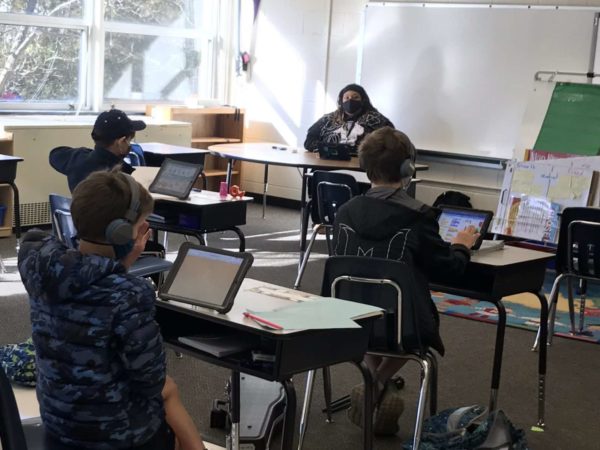
Seven years after the initial rollout of Arlington Public Schools’ digital learning initiative, and after a year of heavier use due to distance-learning, opinions on tech in schools remain divided.
For today’s students and parents, virtual learning during the pandemic only highlighted the benefits of and exacerbated the drawbacks to iPads and laptops. Parents say their kids struggle to focus, navigate programs and engage with the material. Students tell ARLnow that the devices can make their learning easier, more efficient and more interesting, but some have also outsmarted controls to watch TV and play games.
“They help you out. You can just search up anything you need there,” said Liam, a rising seventh-grader in APS. He added that it’s easier to stay on top of work and grades online using Canvas, the division’s learning management system, saying “you can see if you have any missing assignments, and if you’re doing well in school or not.”
Views appear to remain as entrenched as they were in 2019, when North Carolina State University studied tech use and support for devices in APS. At the time, 55% of parents supported the initiative, compared to the 85% of teachers and 75% of students who said devices improved the learning experience.
Through its initial rollout, APS aimed to give each 2nd-12th grade student a tablet or laptop for school use by 2017. From 2017 up until the pandemic, APS provided iPads to all students between third and eighth grade and MacBook Airs to high school students.
Today, the school system uses approximately 34,000 student devices, including both individual devices and shared computers, according to an APS spokesperson. This includes all K-2 students, who were given iPads during the pandemic to facilitate virtual learning when schools were closed. This year, K-2 students will continue to have access to individual devices.
Most students will be in-person this fall, using their devices in the classroom setting. About 890 will be learning fully at a distance, due to the pandemic and personal preference. That preference is set to eventually give rise to a full-time, APS-run virtual learning academy for those who want the flexibility provided by learning at home on their own time.
Over the last year, iPads and MacBooks were how students interacted with teachers and classmates and completed assignments via Microsoft Teams and Google Workspace apps, along with apps such as Dreambox, which offers interactive math lessons and games, and Seesaw, which is like the digital equivalent of a homework folder that both teachers and parents can access.
“Our kids are using their iPads for content delivery, for collaboration, and for writing, reading, and simulation. Creatively, they’re also doing activities and learning through research and creating projects,” Arlington Traditional School instructional technology coordinator Marie Hone said.
Rising fourth-grader Spencer suggests that without iPads, virtual learning would have been more difficult.
“We were able to have calls with our teacher and meet together for school, unlike the year before that,” he said.
Pre-pandemic, high schoolers Anthony Doll and Wyatt Shoelson say that they used their MacBooks in just about every class.
“MacBooks make it easier to keep everything in one place. Typing everything out and going on websites for classes is easier. It’s better to do it electronically than on paper,” Doll said. “My high school experience would be a lot more disorganized without MacBooks.”
Still, concerns remain. Rising second-grader Cecilia Leonard tells ARLnow that the approximately three hours she spent on her iPad throughout the school day hurt her eyes. Experts say that kids who spend too much time on screens may experience eye fatigue and sleep problems.
Middle and elementary school students also tell stories of classmates circumventing device restrictions to play video games and stream videos.
“There are these websites that are pretty much educational, but there’s also a non-educational twist to them, and you can play games on them. We also figured out you can watch Hulu on certain websites,” Spencer said.
And parents? Some have been critical of the program since 2014, when they said it was put in the budget with little public input. After watching their kids learn online for a full year, some parents are not convinced they help. Whether during Arlington School Board meetings or on online forums, some parents continue to be concerned about whether iPads and MacBooks help students or hurt them.
“Devices are not the answer to teach kids. Many kids craved paper and were denied. The iPad was a wonderful connection device but difficult for production and navigation of several tabs for middle school kids,” said parent Kelly Alexis, who manages the Facebook group Arlington Education Matters, where much discussion over iPads and laptops has taken place.
Earlier this year, a father told ARLnow, and members of Congress, that his son and daughter, both with special needs, just could not use the device consistently, and would get frustrated and shut down, no matter how much he and his wife worked with him.
In December, two mothers said their regular-education children sometimes struggled to navigate the devices and complete their work well, which turned into a loss of interest and focus and devolved into mental wellbeing struggles.
ARLnow opinion columnist Peter Rousselot is also a critic of the program, and has urged for reforms and state guidance over the years. He recently called on parents to ensure that APS is monitoring the health and safety of students while using the devices.
Hone pushed back on these concerns, noting that teachers and students were given lessons on how to teach with and use the technology.
“It’s not that we just hand them a device and the device is a magic bullet. It’s done through intentional integration. We start with what do we teach? What’s the tool to teach with?” he said.
Image via APS/Twitter

